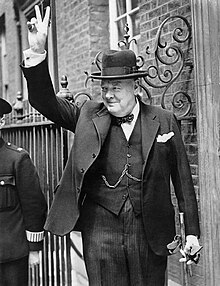
Back علامة النصر Arabic Знак на победата Bulgarian Signe V Catalan V-tegn Danish Victory-Zeichen German V signo Esperanto V (seña) Spanish V (ikurra) Basque نماد V Persian Signe V French

| ✌ | |
|---|---|
V sign | |
| In Unicode | U+270C ✌ VICTORY HAND |
| Different from | |
| Different from | U+1F594 🖔 REVERSED VICTORY HAND |
| Related | |
| See also | U+262E ☮ PEACE SYMBOL U+01F54A 🕊 DOVE OF PEACE |
The V sign is a hand gesture in which the index and middle fingers are raised and parted to make a V shape while the other fingers are clenched. It has various meanings, depending on the circumstances and how it is presented.
When displayed with the palm inward toward the signer, it can be an offensive gesture in some Commonwealth nations (similar to showing the middle finger), dating back to at least 1900. When given with the palm outward, it is to be read as a victory sign ("V for Victory"); this usage was introduced in January 1941 as part of a campaign by the Allies of World War II,[1] and made more widely known by Winston Churchill. During the Vietnam War, in the 1960s, the "V sign" with palm outward was widely adopted by the counterculture as a symbol of peace and still today in the United States and worldwide as the "peace sign".
- ^ Cosgrove, Ben (4 July 2014). "V for Victory: Celebrating a Gesture of Solidarity and Defiance". Time (magazine).
© MMXXIII Rich X Search. We shall prevail. All rights reserved. Rich X Search